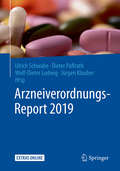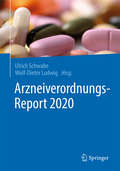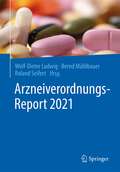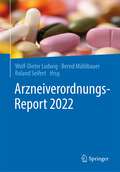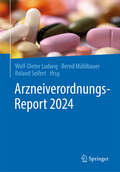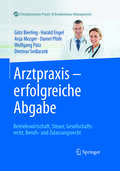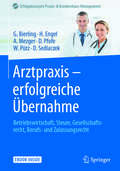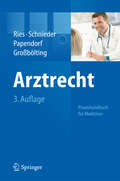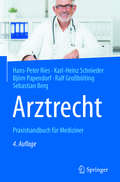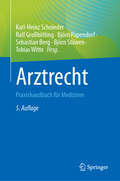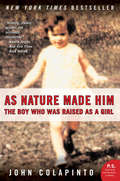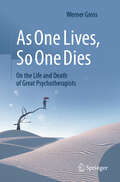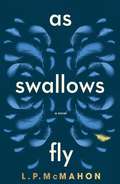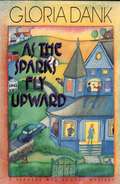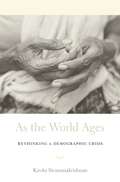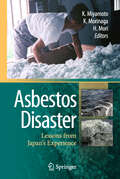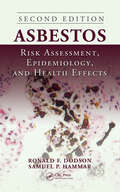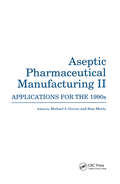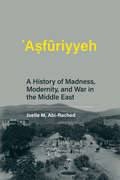- Table View
- List View
Arzneiverordnungs-Report 2019
by Wolf-Dieter Ludwig Jürgen Klauber Ulrich Schwabe Dieter PaffrathIm Arzneiverordnungs-Report werden seit 1985 Daten, Kosten und Analysen zur Verordnung von Arzneimitteln für die Patienten der gesetzlichen Krankenversicherung (GKV) publiziert. Datenbasis des Jahres 2018 sind 800 Millionen Verordnungen von 147.713 Vertragsärzten und 65.513 Vertragszahnärzten für 72,997 Mio. GKV-Versicherte.Die allgemeine Verordnungs- und Marktentwicklung wird in 8 Kapiteln dargestellt, in denen zusätzlich europäische Zulassungsverfahren, 37 neue Arzneimittel des Jahres 2018, Biologika und Biosimilars, Orphan-Arzneimittel, Ergebnisse des AMNOG-Erstattungsbetragsverfahrens und europäische Arzneimittelpreise thematisiert werden. Die speziellen Verordnungsdaten der 3000 meistverordneten Arzneimittel (Markterfassung 98%) werden in 39 Kapiteln über die führenden Indikationsgruppen evidenzbasiert analysiert.Aus dem InhaltAllgemeine Verordnungs- und MarktentwicklungIndikationsgruppenErgänzende statistische Übersicht
Arzneiverordnungs-Report 2020
by Wolf-Dieter Ludwig Ulrich SchwabeDer Arzneiverordnungs-Report ist seit 1985 eine gemeinsame Publikation von Autoren aus Pharmakologie, Klinik, Praxis, Gesundheitsökonomie und Krankenversicherung. Basis sind die Verordnungsdaten von Arzneimitteln für ambulante Patienten der gesetzlichen Krankenversicherung (GKV). Datenbasis des Jahres 2019 sind 820 Millionen Verordnungen von 179.805 Vertragsärzten und 63.360 Vertragszahnärzten für 73,195 Mio. GKV-Versicherte.Die allgemeine Verordnungs- und Marktentwicklung wird in 5 Kapiteln dargestellt, in denen zusätzlich 31 neue Arzneimittel des Jahres 2019, Biologika und Biosimilars, 10 Jahre AMNOG und europäische Arzneimittelpreise für Biosimilars thematisiert werden. Die speziellen Verordnungsdaten der 3000 meistverordneten Arzneimittel werden in 39 Kapiteln für die führenden Indikationsgruppen evidenzbasiert analysiert.
Arzneiverordnungs-Report 2021
by Wolf-Dieter Ludwig Roland Seifert Bernd MühlbauerDer Arzneiverordnungs-Report ist seit 1985 eine gemeinsame Publikation von Autoren aus Pharmakologie, Klinik, Praxis, Gesundheitsökonomie und Krankenversicherung. Basis sind die Verordnungsdaten von Arzneimitteln für ambulante Patienten der gesetzlichen Krankenversicherung (GKV). Datenbasis des Jahres 2020 sind ca. 820 Mio. Verordnungen von 150.363 Vertragsärzten und 62.876 Vertragszahnärzten für 73,4 Mio. GKV-Versicherte. Die allgemeine Verordnungs- und Marktentwicklung wird in 6 Kapiteln behandelt, in denen u.a. neue Arzneimittel des Jahres 2020, die Kosten-Nutzen-Analyse von onkologischen Arzneimitteln, Marktsteuerungsmechanismen und Preise von Biologika bzw. Biosimilars sowie die Klassifizierung von Arzneistoffgruppen diskutiert werden.Die Nettokosten für Arzneimittel in der GKV sind 2020 weiter um 5 % auf rund 46 Mrd. € gestiegen, vor allem durch neue, hochpreisige Patentarzneimittel. Hauptkostentreiber waren Onkologika (9,5 Mrd. €, + 12,4 %) und Antidiabetika (2,8 Mrd. €, + 16,8 %). Ein wesentlicher Grund für die Kostenprobleme ist der seit Jahren beobachtete Anstieg der Jahrestherapiekosten neu eingeführter Arzneimittel. Dieser Trend zu hochpreisigen Patentarzneimitteln ist durch das Arzneimittelmarktneuordnungsgesetz (AMNOG) sogar 10 Jahre nach seiner Einführung nicht genügend abgeschwächt worden, auch wenn mit der Vereinbarung von Erstattungsbeträgen 2020 insgesamt 3,7 Mrd. € an Einsparungen erzielt werden konnten.
Arzneiverordnungs-Report 2022
by Wolf-Dieter Ludwig Roland Seifert Bernd MühlbauerDer Arzneiverordnungs-Report ist seit 1985 eine gemeinsame Publikation von Autoren aus Pharmakologie, Klinik, Praxis, Gesundheitsökonomie und Krankenversicherung. Basis sind die Verordnungsdaten von Arzneimitteln für ambulante Patienten der gesetzlichen Krankenversicherung (GKV).
Arzneiverordnungs-Report 2023
by Wolf-Dieter Ludwig Roland Seifert Bernd MühlbauerDer Arzneiverordnungs-Report ist seit 1985 eine gemeinsame Publikation von Autoren aus Pharmakologie, Klinik, Praxis, Gesundheitsökonomie und Krankenversicherung. Basis sind die Verordnungsdaten von Arzneimitteln für ambulante Patienten der gesetzlichen Krankenversicherung (GKV).
Arzneiverordnungs-Report 2024
by Wolf-Dieter Ludwig Roland Seifert Bernd MühlbauerDer Arzneiverordnungs-Report ist seit 1985 eine gemeinsame Publikation von Autoren aus Pharmakologie, Klinik, Praxis, Gesundheitsökonomie und Krankenversicherung. Basis sind die Verordnungsdaten von Arzneimitteln für ambulante Patienten der gesetzlichen Krankenversicherung (GKV).
Arzthaftung und Verjährung
by Benjamin GoehlDieses Buch analysiert die praxisrelevante Frage der Verjährung von Arzthaftungsansprüchen. In einem ersten Teil werden die dogmatischen Grundlagen der Verjährung dargestellt. Auf dieser Basis erfolgt eine Untersuchung der Voraussetzungen des Verjährungsbeginns im Allgemeinen. Den Schwerpunkt bildet dabei die Auslegung der Begriffe der Kenntnis und der grob fahrlässigen Unkenntnis des Gläubigers. Zugleich bietet das Buch einen Überblick über die Auslegung der Verjährungsregeln durch die Praxis, insbesondere den BGH. Der dritte Teil des Buches widmet sich den Problemen der Verjährung im Kontext der Arzthaftung. Es unterscheidet zwischen der Haftung für Behandlungs- und Aufklärungsfehler und bietet eine umfassende Rechtsprechungsanalyse. Es werden die im Rahmen der Verjährung zu berücksichtigenden Besonderheiten in Arzthaftungsfällen, auch solche des Prozessrechts, herausgearbeitet und untersucht. Im Wege einer Fallgruppenbildung werden Lösungsansätze für typische Problemfälle angeboten.
Arztpraxis - erfolgreiche Abgabe: Betriebswirtschaft, Steuer, Gesellschaftsrecht, Berufs- und Zulassungsrecht (Erfolgskonzepte Praxis- & Krankenhaus-Management)
by Götz Bierling Harald Engel Anja Mezger Daniel Pfofe Wolfgang Pütz Dietmar SedlaczekDieses Buch bietet Ihnen alle Informationen, um die Abgabe Ihrer Arztpraxis strategisch optimal zu planen. Was muss lang-, mittel- und kurzfristig beachtet werden. Irgendwann ist der Zeitpunkt gekommen, an dem jeder Arzt seine Praxis oder seine Praxisanteile abgeben wird. Dies kann aus den unterschiedlichsten Gründen erfolgen und stellt den Praxisinhaber oftmals vor viele organisatorische Herausforderungen. Warum sollte man sich also jetzt schon Gedanken um die eigene Praxisabgabe machen? Ganz einfach: Die Vielschichtigkeit der Praxisabgabe wird häufig unterschätzt und ihre Abgabe gestaltet sich nicht mehr so einfach wie noch vor einigen Jahren. Sie ist infolge immer umfangreicher werdender rechtlicher Rahmenbedingungen ein inzwischen sehr komplexes Konstrukt. Gerade die Attraktivität der eigenen Praxis zu steigern und so ihren Wert zu sichern ist nur mit einer frühzeitigen Planung möglich. Sie sind daher als Praxisinhaber gefordert, sich rechtzeitig auf die Praxisabgabe vorzubereiten und frühzeitig mit den Problemen auseinanderzusetzen. Denn Praxisabgaben können besonders dann scheitern, wenn man sich zu spät mit diesem Thema beschäftigt. Dieses Buch richtet sich daher an alle Ärzte, gleichgültig ob sie eine eigene Praxis haben oder den Beruf mit anderen Ärzten gemeinsam ausüben, und soll ihnen den Weg für eine erfolgreiche Praxisabgabe weisen. Rechtsanwälte, Steuerberater, Betriebswirte und Vertreter der Kassenärztlichen Vereinigung haben dieses Buch gemeinsam erarbeitet, um dem Leser so ausführliche und umfassende Einblicke aus den verschiedenen Perspektiven zu vermitteln. Entscheiden Sie sich dazu, die Ratschläge dieses Buches zu berücksichtigen, so steht Ihrer erfolgreichen Praxisabgabe nichts mehr im Wege.
Arztpraxis - erfolgreiche Übernahme: Betriebswirtschaft, Steuer, Gesellschaftsrecht, Berufs- und Zulassungsrecht (Erfolgskonzepte Praxis- & Krankenhaus-Management)
by Götz Bierling Harald Engel Anja Mezger Daniel Pfofe Wolfgang Pütz Dietmar SedlaczekDieses Buch bietet Ihnen alle Informationen, um die Übernahme bzw. Neugründung Ihrer Arztpraxis strategisch optimal zu planen. Was muss lang-, mittel- und kurzfristig beachtet werden.<P><P> Für viele Ärzte ist irgendwann der Zeitpunkt gekommen, an dem sie sich niederlassen und auf eigenen Beinen stehen wollen. Dies kann aus den unterschiedlichsten Gründen erfolgen und stellt den Praxisinhaber in spe vor viele organisatorische Herausforderungen.<P> Warum sollte man sich schon frühzeitig Gedanken um die eigene Praxis machen?<P> Ganz einfach: Die Vielschichtigkeit der Praxisübernahme oder -neugründung wird häufig unterschätzt und ihre Übernahme/Gründung gestaltet sich nicht mehr so einfach wie noch vor einigen Jahren. Sie ist infolge immer umfangreicher werdender rechtlicher Rahmenbedingungen ein inzwischen sehr komplexes Konstrukt. Gerade die Attraktivität der zukünftigen Praxis zu steigern und so ihren Wert zu sichern ist nur mit einer frühzeitigen Planung möglich. Sie sind daher als Praxisinhaber in spe gefordert, sich rechtzeitig auf Ihre neue Praxis vorzubereiten und frühzeitig mit den Herausforderungen auseinanderzusetzen. Denn Praxisübernahme oder -neugründung können besonders dann scheitern, wenn man sich zu spät mit diesem Thema beschäftigt.<P> Dieses Buch richtet sich daher an alle zukünftigen Praxiseigentümer, gleichgültig ob sie eine eigene Praxis haben werden oder den Beruf mit anderen Ärzten gemeinsam ausüben wollen, und soll ihnen den Weg für eine erfolgreiche Praxisübernahme oder -neugründung weisen.<P> Rechtsanwälte, Steuerberater, Betriebswirte und Vertreter der Kassenärztlichen Vereinigung haben dieses Buch gemeinsam erarbeitet, um dem Leser so ausführliche und umfassende Einblicke aus den verschiedenen Perspektiven zu vermitteln. <P> Entscheiden Sie sich dazu, die Ratschläge dieses Buches zu berücksichtigen, so steht Ihrer erfolgreichen Praxisübernahme oder -neugründung nichts mehr im Wege.
Arztrecht: Praxishandbuch für Mediziner
by Karl-Heinz Schnieder Björn Papendorf Hans-Peter Ries Ralf GroßböltingJeder Arzt ist rechtlichen Regelungen unterworfen, die sich häufig ändern, und deren Folgen im Konfliktfall schnell und präzise eingeschätzt werden müssen. Ein Team anerkannter Experten stellt die komplizierte Materie praxisnah, in übersichtlicher Form und anhand zahlreicher Beispiele dar. Das Handbuch enthält Checklisten, liefert Entscheidungshilfen sowie Verteidigungsstrategien. In die 3. Auflage sind alle Änderungen durch das Arzneimittelneuordnungsgesetz (AMNOG), das GKV-Finanzierungsgesetz (GKV-FinG 2011) und das Versorgungsstrukturgesetz 2012 eingeflossen.
Arztrecht: Praxishandbuch für Mediziner
by Karl-Heinz Schnieder Björn Papendorf Hans-Peter Ries Ralf Großbölting Sebastian BergKlare Entscheidungs- und Argumentationshilfe: Ein Team anerkannter Experten, unter ihnen drei Fachanwälte für Medizinrecht, stellt die komplizierte Materie übersichtlich und verständlich dar. Ärzte sind einer Fülle von häufig wechselnden rechtlichen Regelungen unterworfen, deren Folgen sie im Konfliktfall schnell und präzise einschätzen müssen. Zahlreiche Beispiele, Checklisten und Verteidigungsstrategien zur sofortigen Umsetzung bieten hier rasche Orientierung zur Klärung aller relevanten Rechtsfragen. Plus in dieser 2. , aktualisierten und erweiterten Auflage: die aktuelle Rechtsprechung und die anstehenden erheblichen gesetzlichen Änderungen.
Arztrecht: Praxishandbuch für Mediziner
by Karl-Heinz Schnieder Björn Papendorf Ralf Großbölting Sebastian Berg Björn Stäwen Tobias WitteDieses Buch gibt praxistaugliche Antworten auf sämtliche Fragestellungen, die sich dem niedergelassenen Arzt im Rahmen seiner beruflichen Tätigkeit stellen. Diese Frage- und Problemstellungen wirken sich oftmals in erheblichem Maße aus – sei es persönlich im Verhältnis zum Patienten, finanziell im Verhältnis zu den Körperschaften oder hinsichtlich der eigenen beruflichen Perspektive. Der niedergelassene Arzt ist immer weniger allein Mediziner, sondern auch selbständiger Unternehmer, der die sich wandelnden Bedürfnisse der Patienten ebenso zu beachten hat, wie die sich stets im Wandel befindliche Rechtslage. Dieses Buch ist für den Arzt ein übersichtlicher und verständlicher Ratgeber – ein Wegweiser durch den regulatorischen Dschungel. Einen Schwerpunkt des Buchs bildet dabei der Bereich des Vertragsarztrechts mit seinen vielfältigen rechtlichen Verästelungen und Problemstellungen. In die Neuauflage sind neben den die berufliche Tätigkeit des Arztes beeinflussenden gesetzlichenNeuerungen, beispielsweise das Terminservice- und Versorgungsgesetz, vor allem auch die aktuellen Grundsätze der höchstrichterlichen Rechtsprechung eingearbeitet, um eine größtmögliche Aktualität zu gewährleisten. Aufgrund der praktischen Relevanz und des digitalen Fortschritts ist auch ein eigenständiges Kapitel zum Datenschutzrecht sowie der damit korrespondierenden Telemedizin in der Neuauflage enthalten. Daneben werden ebenfalls wie gewohnt alle wesentlichen praxisrelevanten Rechtsgebiete wie das Berufsrecht, das Haftpflichtrecht, das Arbeitsrecht, das Disziplinarrecht sowie das Familien- und Mietrecht dargestellt.
As I Live and Breathe: Notes of a Patient-Doctor
by Jamie WeismanFrom the Publisher: Jamie Weisman was a patient long before she was a doctor. She was born with a rare defect in her immune system that leaves her prey to a range of ailments and crises and that, because it is treatable but not curable, will keep her a patient for life. Her history has graced her with a deeper perspective -- a second sight, in a sense -- on the body itself, in all its frailty, glory, and irreducible mystery. In this probing and inspiring book, Weisman brings her sojourns on both sides of the doctor-patient divide to bear on the issues of the flesh that preoccupy us all. She considers the randomness of illness, and the fears and fortitude it calls forth in those it strikes. She weighs the economic and moral value of sustaining any given life. She explores the vulnerabilities of the body and of those who care for it, including their capacity for error. And she conveys, by eloquent example, that the only cure for the fear of death is living. As I Live and Breathe is a view of medicine from both sides of the trenches, embracing the patient's fervent desire for health and the doctor's fervent desire to grant it. It is a worthy addition to the best that has been written about our physical selves, a meditation on our extraordinary powers of healing and the limitations that leave intact the miracle and tragedy of being.
As I Recall: Discovering the Place of Memories in Our Spiritual Life
by Casey TygrettWhat if our memories are like shells we gather on a beach? According to pastor and spiritual director Casey Tygrett, "We—and all those who have come before us—pick up the experience and we sense it: we feel its edges, notice its color, we smell the distinctive character (for shells it is the sickly seafood salt smell) of the experience and we try to make sense of what it is. Is it beautiful? How would you describe the color—the tones, the shades, wrapped around the ridges and swirls? Has it been damaged? Does the hard edge scrape our hand, leaving a blemish or a mark?" How we hold and carry these memories—good and bad—is a part of what forms us spiritually. In this way we have a common bond with the people of Scripture who also had a sensory life, gathering shells and trying to make sense of them. In these pages Casey Tygrett explores the power of memory and offers biblical texts and practices to guide us in bringing our memories to God for spiritual transformation.
As Nature Made Him
by John Colapinto<P>In 1967, after a baby boy suffered a botched circumcision, his family agreed to a radical treatment. <P> On the advice of a renowned expert in gender identity and sexual reassignment at Johns Hopkins Hospital, the boy was surgically altered to live as a girl. This landmark case, initially reported to be a complete success, seemed all the more remarkable since the child had been born an identical twin: his uninjured brother, raised as a boy, provided to the experiment the perfect matched control. <P>The so-called twins case would become one of the most famous in modern medicine and the social sciences; cited repeatedly over the past thirty years as living proof that our sense of being male or female is not inborn but primarily the result of how we are raised. <P>The case was a failure from the outset because the twin struggled against his imposed girlhood. At fourteen, when told of his medical history, he made the decision to live as a male. <P>John Colapinto tells this extraordinary story for the first time in As Nature Made Him. The human intimacy of the story is all the greater for the subject's courageous decision to step out from behind the pseudonym that has shrouded his identity for the past thirty years.
As One Lives, So One Dies: On the Life and Death of Great Psychotherapists
by Werner GrossThis non-fiction book addresses the major theme of life and death in a unique way: it focuses on the founders of psychotherapy schools and discusses their lifestyle, their style of dying, and their work. How did they live? What trials and tribulations did they go through in the course of their lives? What crises did they experience, and how did they overcome them? What conclusions did they draw from these experiences? And finally: how did they die? Engaging and easy to read, it reveals that their attitude towards life and death influences the development of their respective psychotherapy methods. Written for interested laypeople, practicing and training psychotherapists, psychiatrists, and counselors. Content Overview: Freud, Jung, Adler, Moreno, Perls, Reich, von Dürckheim, Peseschkian – their perspectives on life and death and its significance for their psychotherapy schools. About the Author: Werner Gross, Dipl.-Psych., psychotherapist, supervisor and coach, organizational and business consultant.
As Swallows Fly
by L.P. McMahonWhen Malika, a young orphan in rural Pakistan, is savagely attacked, her face is left disfigured and her self-esteem destroyed. Haunted by the assault, she hides from the world, finding solace in her mathematical theories. A few years later, her intellectual brilliance is discovered and she leaves conflict-stricken Pakistan for a better education in Melbourne, where she finds herself placed with Kate—a successful plastic surgeon facing emotional insecurities of her own. Malika and Kate&’s lives slowly intertwine as they find within each other what each has lacked alone. At first, Kate&’s skills appear to offer a simple solution to Malika&’s anguish, but when tragedy strikes, the price of beauty is found to be much higher than either of them could have known. As Swallows Fly is a poignant portrayal of survival, identity and empowerment in a culture dominated by the pursuit of perfection. In a captivating and unforgettable debut, McMahon asks what might be possible if we have the courage to be flawed.
As the Sparks Fly Upward (Bernard and Snooky)
by Gloria DankBernard Woodruff should have known better than to expect anything but disaster from a visit to his wife's indolent but good-natured brother, Snooky. In a cabin in the Vermont woods, the irrepressible Snooky rhapsodizes about the simple pleasures of country living while preparing gourmet meals and falling in love with Sarah Tucker, a young woman whose family life is anything but simple. Bernard's depression at being away from home only deepens after he meets Sarah's assortment of relatives. There's a wealthy widowed aunt with a much younger admirer, an eccentric nature-loving spinster, a young photographer, and a blustering hunter, none of whom Bernard finds at all to his liking. But when Bernard never likes anyone, as his wife, Maya, keeps pointing out in an attempt to save Snooky's bruised feelings. Bernard is still grumbling when he stumbles on a corpse in the woods. It turns out to be the remains of the young man who had just become engaged to Sarah's rich aunt, and everyone in the family falls under suspicion. Against his will, Bernard is drawn into the murder investigation. By the end, he and Snooky join forces to track down an elusive and unlikely killer.
As the World Ages: Rethinking a Demographic Crisis
by Kavita Sivaramakrishnan SivaramakrishnanPeople are living longer, creating an unexpected boom in the elderly population. Longevity is increasing not only in wealthy countries but in developing nations as well. In response, many policy makers and scholars are preparing for a global crisis of aging. But for too long, Western experts have conceived of aging as a universal predicament—one that supposedly provokes the same welfare concerns in every context. In the twenty-first century, Kavita Sivaramakrishnan writes, we must embrace a new approach to the problem, one that prioritizes local agendas and values. As the World Ages is a history of how gerontologists, doctors, social scientists, and activists came to define the issue of global aging. Sivaramakrishnan shows that transnational organizations like the United Nations, private NGOs, and philanthropic foundations embraced programs that reflected prevailing Western ideas about development and modernization. The dominant paradigm often assumed that, because large-scale growth of an aging population happened first in the West, developing societies will experience the issues of aging in the same ways and on the same terms as their Western counterparts. But regional experts are beginning to question this one-size-fits-all model and have chosen instead to recast Western expertise in response to provincial conditions. Focusing on South Asia and Africa, Sivaramakrishnan shows how regional voices have argued for an approach that responds to local needs and concerns. The research presented in As the World Ages will help scholars, policy makers, and advocates appreciate the challenges of this recent shift in global demographics and find solutions sensitive to real life in diverse communities.
Asbestos Disaster: Lessons from Japan's Experience
by Kenji Morinaga Mori Hiroyuki Kenichi MiyamotoJapan's asbestos disasters, encompassing both occupational disease and environmental pollution, have been caused principally by the asbestos textile, asbestos cement water pipe, and construction industries. This book is unique in its interdisciplinary approach to those disasters as it incorporates medical science, economics, political science, law, architecture, environmental engineering, sociology, and journalism. Written by authorities in their fields, the chapters reflect the integration of these disciplines in topics that include a historical review of asbestos issues in Japan, asbestos-related diseases, international aspects of the asbestos industry, public policy, divisions of responsibility, relief activities in emergencies, and countermeasures enacted by local governments. The lessons of asbestos problems and policies in Japan are particularly important for developing countries to prevent the proliferation of asbestos disasters. This volume serves as a textbook on asbestos issues for all countries, especially where there is widespread use of asbestos.
Asbestos: Risk Assessment, Epidemiology, and Health Effects
by Michele Carbone, Ronald F. Dodson, Harvey Pass, and Haining YangAsbestos: Risk Assessment, Epidemiology, and Health Effects offers a key text on the evolving information regarding asbestos and human health. Now in its third edition, this bestseller explores the pathological complexities of asbestos-related disease and examines how asbestos induces diseases in biological systems. The book also discusses the types of instruments and methods available for evaluation of the content of asbestiform minerals in products, air, water, surface areas, and tissue. It explains the relevance of each of these applications and gives readers the tools to evaluate data in the future.Edited by leading authorities on the subject and with contributions from a team of international experts, this book takes a cross-disciplinary approach and an authoritative review of the history, pathology, epidemiology, sampling, and analysis of asbestos. Backed up with photos and numerous diagrams, tables, and photographs, it features case studies, methodologies, and sampling/analytical schemes that put learning into context. Fully up-to-date and featuring four brand new chapters covering asbestosis and immunity, asbestos litigation and surgical and non-surgical management of mesothelioma, this book remains the most comprehensive source of information on asbestos and the only guide the reader will ever need to own.This essential text will appeal to any professional at any level who requires the latest expertise in dealing with asbestos. It suits researchers and practitioners alike, as well as those in the fields of law, health, education, hospitality, emergency response, building management and maintenance, construction, safety, insurance, and industrial hygiene.
Asbestos: Risk Assessment, Epidemiology, and Health Effects, Second Edition
by Samuel P. Hammar Ronald F. DodsonThe first edition of Asbestos: Risk Assessment, Epidemiology, and Health Effects received critical acclaim due to the interdisciplinary nature of its content. Editors Ronald Dodson and Samuel Hammar have carefully kept this popular focus while updating and expanding the topics covered in the first edition with the help of internationally known expe
Aseptic Pharmaceutical Manufacturing II: Applications for the 1990s
by Michael J. Groves; Ram MurtyAsceptic Pharmaceutical Manufacturing II explores the sophisticated technology, developments, and applications that allow aseptic processing to approach the sterility levels achieved with terminal sterilization. Written by experts in sterile manufacturing, this book covers aseptic technology, developments, and applications and makes a valuable contribution to understanding the issues involved in aseptic manufacture. Topics include the processing of biopharmaceuticals, lyophilization, personnel training, radiopharmaceuticals, hydrogen peroxide vapor sterilization, regulatory requirements, validation, and quality systems.
Asfuriyyeh: A History of Madness, Modernity, and War in the Middle East (Culture and Psychiatry)
by Joelle M Abi-RachedThe development of psychiatry in the Middle East, viewed through the history of one of the first modern mental hospitals in the region.ʿAṣfūriyyeh (formally, the Lebanon Hospital for the Insane) was founded by a Swiss Quaker missionary in 1896, one of the first modern psychiatric hospitals in the Middle East. It closed its doors in 1982, a victim of Lebanon's brutal fifteen-year civil war. In this book, Joelle Abi-Rached uses the rise and fall of ʿAṣfūriyyeh as a lens through which to examine the development of modern psychiatric theory and practice in the region as well as the sociopolitical history of modern Lebanon.
Ashamed to Die: Silence, Denial, and the AIDS Epidemic in the South
by Andrew SkerrittBy focusing on a small town in South Carolina, this study of the HIV/AIDS crisis in the South reveals the hard truths of an ongoing and complex issue. Skerritt contends that the United States has failed to adequately address the threat of HIV and AIDS in communities of color and that taboos about love, race, and sexuality--combined with Southern conservatism, white privilege, and black oppression--continue to create an unacceptable death toll. The heartbreak of America's failure comes alive through case studies of individuals such as Carolyn, a wild child whose rebellion coincided with the advent of AIDS, and Nita, a young woman searching for love and trapped in an abusive relationship. The results are most visible at the town's segregated burial ground where dozens of young black men and women who have died from AIDS are laid to rest. Not only a call to action and awareness, this is a true story of how persons of faith, enduring love, and limitless forgiveness can inspire others by serving as guides for poor communities facing a public health threat burdened with conflicting moral and social conventions.
